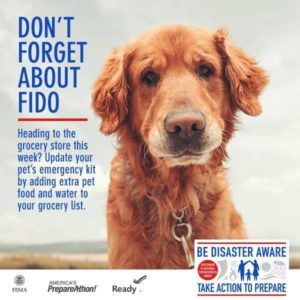After watching two people and their big dog being rescued by boat in New Jersey on CNN the other day, it seemed like a good time to write about disaster preparedness for our animals.
Since farm animals are more complicated to plan for, we will stick with the more common animals like dogs and cats. Just as we need to be able to take care of ourselves, we need to know what to do for our pets as well. And while I can never remember exactly what Murphy’s law says, I am hopeful that, if we are fully prepared, it won’t apply to us.
The first step is to make sure each pet is wearing a tag or collar with its name, your name, phone number, and critical medical information. Believe it or not, a 2010 study showed that 73 percent of cats will actually wear a collar for at least 6 months. Getting humans to put collars on their cats is an important feline welfare subject. Fewer than 2 percent of lost cats are returned to their owners, and most unidentified cats that enter shelters are euthanized. Increasing the number of identifiable animals is critical to getting cats home. Make sure the microchip, if the cat has one, has the most up-to-date information. If it is not microchipped, talk to your vet about placing one at your next visit.
 A clearly labeled go bag and go carrier should be ready at all times, and the whole family should be able to find it. For both species, have three to seven days of wet food or dry food ready (rotate supplies every two months to avoid spoilage), a 14-day supply of medications, and seven days’ worth of water. These should also be rotated.
A clearly labeled go bag and go carrier should be ready at all times, and the whole family should be able to find it. For both species, have three to seven days of wet food or dry food ready (rotate supplies every two months to avoid spoilage), a 14-day supply of medications, and seven days’ worth of water. These should also be rotated.
A small first-aid kit and a booklet on pet care are very valuable. Have recent photos of your pets in case you are separated. Make sure you have a paper record of pets’ recent vaccinations and, if possible, a thumb drive or paper copies with pertinent medical records. For dogs, you should have a labeled extra leash as well as plastic poop bags. Cats should have a sturdy, unbroken carrier, a small amount of litter, small bags to dispose of used litter, and a small pan (aluminum roasting pans work well, but don’t think of re-using them for cooking.)
The final but critical element of disaster preparedness is deciding where to go with your pet and supplies. It is your responsibility to find out if your town or city emergency shelter will accept animals and what the protocols are. See if nearby hotels will take pets, if an out-of-town friend will take them, or if animal shelters will temporarily take them.
This can be one of the most challenging aspects of disaster planning, but it is essential, so use the time you have now and the motivation from the news all around us to plan. The next time we get a midnight tornado warning, we will have one less thing to worry about.
Sadie Hutchings, D.V.M., practices at the Herring Cove Animal Hospital in Provincetown.



